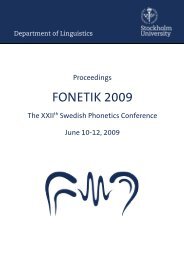The Double Passive in Swedish - Institutionen för lingvistik ...
The Double Passive in Swedish - Institutionen för lingvistik ...
The Double Passive in Swedish - Institutionen för lingvistik ...
Create successful ePaper yourself
Turn your PDF publications into a flip-book with our unique Google optimized e-Paper software.
Example (51) and (52), illustrates the mapp<strong>in</strong>g of subject and object control verbs, and to which<br />
category each of the ten verbs was manually sorted. 17<br />
Subject control verbs: ’riskera’ (’risk’), planera (’plan’), ’beräkna’ (’calculate’), ’avse’ (’<strong>in</strong>tend’),<br />
’påstå’ (’argue’).<br />
(51) a) Pete avse-r att slå Patty.<br />
3SG <strong>in</strong>tend-PRS to:COMP beat:INF 3SG.<br />
‘Pete <strong>in</strong>tends to beat Patty’.<br />
b) *Pete avse-r Patty att slå<br />
3SG <strong>in</strong>tend-PRS 3SG to:COMP beat-INF<br />
‘Pete <strong>in</strong>tends Patty to beat’.<br />
Object control verbs: ’tv<strong>in</strong>ga’ (’force’), ’hota’ (’threat’), ’<strong>för</strong>vänta’ (’expect’), ’tillåta’ (’allow’),<br />
‘<strong>för</strong>eslå’ (‘suggest’).<br />
(52) a) *Pete tv<strong>in</strong>gar-r att renovera huset.<br />
3SG force-PRS to:COMP renovate:INF house:the.<br />
‘Pete forces to renovate the house.’<br />
b) Pete tv<strong>in</strong>gar-r Patty att renovera huset.<br />
3SG force-PRS 3SG to:COMP renovate:INF house:the.<br />
‘Pete forces Jane to do the renovations of the house.’<br />
<strong>The</strong> mapp<strong>in</strong>g of the ten verbs collected <strong>in</strong> the corpus research (cf. Table 2), regard<strong>in</strong>g subject and<br />
object control, is shown <strong>in</strong> (Table 6).<br />
Table 6. Subject and object control of the 10 chosen equi<br />
verbs chosen <strong>in</strong> the corpus research.<br />
Subject control verbs Object control verbs<br />
‘avse’ (‘<strong>in</strong>tend’) ‘tv<strong>in</strong>ga’ (‘force’)<br />
‘beräkna’ (‘calculate’) ‘tillåta’ (‘allow’)<br />
‘planera’ (‘plan’) ‘<strong>för</strong>eslå’ (‘suggest’)<br />
‘påstå’ (‘argue’) ‘<strong>för</strong>vänta’ (‘expect’)<br />
‘riskera’ (‘risk’) ‘hota’ (‘threat’)<br />
In the passive counterparts of (51a) <strong>in</strong> (Figure 9), and of (52b) <strong>in</strong> (Figure 10) – the agents are overt <strong>in</strong><br />
both examples. <strong>The</strong> subject control <strong>in</strong> (Figure 10), and the active counterpart <strong>in</strong> (51a) shows that both<br />
the matrix predicate and the <strong>in</strong>f<strong>in</strong>itive predicate assigns a semantic role each to the one and same<br />
“underly<strong>in</strong>g notion” of an agent, (cf. 2.4.3), even if it “occurs” once <strong>in</strong> each clause. <strong>The</strong> overt agent <strong>in</strong><br />
the matrix clause is not normally expressed (nor is the agent <strong>in</strong> the <strong>in</strong>f<strong>in</strong>itival complement) but used <strong>in</strong><br />
the mapp<strong>in</strong>g <strong>in</strong> (Figure 9) and (Figure 10) fore illustrative purposes:<br />
17 Note that the (*) <strong>in</strong> example (51b) and <strong>in</strong> (52a) marks non-subject control or non-object control.<br />
36

















